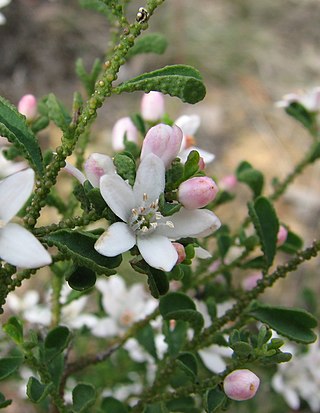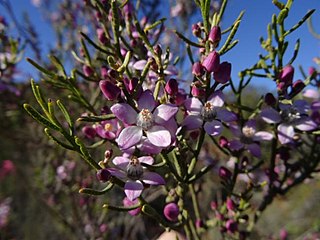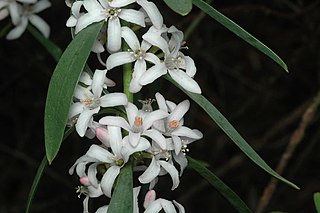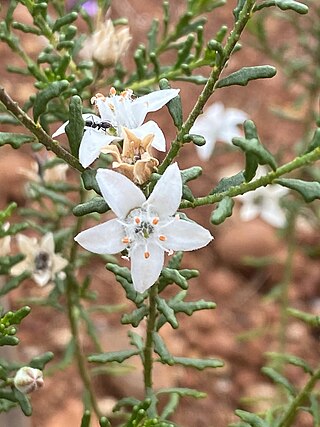
Eriostemon is a genus of flowering plants of the family Rutaceae. It is native to eastern Australia and includes just two species, E. australasius and E. banksii. Eriostemon australasius, commonly known as pink wax flower, occurs between Fraser Island and Nowra and is a shrub of heathlands and low open woodlands. Eriostemon banksii is endemic to Cape York Peninsula and is a shrub or small tree occurring in heathland and rainforest margins.

Philotheca is a genus of about fifty species of flowering plants in the family Rutaceae. Plants in this genus are shrubs with simple leaves arranged alternately along the stems, flowers that usually have five sepals, five petals and ten stamens that curve inwards over the ovary. All species are endemic to Australia and there are species in every state, but not the Northern Territory.

Philotheca verrucosa, commonly known as fairy wax-flower or Bendigo wax-flower, is a species of flowering plant in the family Rutaceae and is endemic to south-eastern Australia. It is a small shrub with prominently glandular-warty branchlets, heart-shaped or egg-shaped leaves with the narrower end towards the base, and white flowers usually arranged singly in leaf axils.

Philotheca salsolifolia is a species of flowering plant in the family Rutaceae and is endemic to New South Wales and the Australian Capital Territory. It is a shrub with crowded, more or less cylindrical leaves and pink to mauve flowers with a dark central stripe and arranged singly or in twos or threes on the ends of branchlets.

Philotheca buxifolia is a species of flowering plant in the family Rutaceae and is endemic to New South Wales. It is a shrub with more or less oblong leaves and solitary white to pink flowers arranged singly on the ends of branchlets.
Philotheca pungens, commonly known as prickly waxflower, is a species of flowering plant in the family Rutaceae and is endemic to south-eastern Australia. It is an undershrub with linear to narrow oblong or needle-like leaves and white flowers usually arranged singly in leaf axils.

Philotheca trachyphylla, commonly known as rock wax-flower, is a species of plant in the family Rutaceae and is endemic to south-eastern Australia. It is a shrub or small tree with glandular-warty, oblong to narrow egg-shaped leaves and white flowers arranged singly or in twos or threes, in leaf axils.

Philotheca angustifolia, commonly known as narrow-leaf wax flower, is a species of flowering plant in the family Rutaceae and is endemic to south-eastern Australia. It is a shrub with small leaves and white flowers with five egg-shaped petals in spring.

Philotheca brucei is a species of flowering plant in the family Rutaceae and is endemic to Western Australia. It is a shrub with cylindrical leaves grooved along the top and in spring, white to pink or mauve flowers with five egg-shaped petals.

Philotheca conduplicata is a species of flowering plant in the family Rutaceae and is endemic to eastern Australia. It is a shrub with elliptical leaves clustered near the ends of the branchlets and white flowers arranged singly or in two or threes on the ends of the branchlets.

Philotheca difformis is a species of flowering plant in the family Rutaceae and is endemic to continental eastern Australia. It is a shrub with variably-shaped leaves depending on subspecies, and white flowers arranged singly or in groups of up to four on the ends of the branchlets. Subspecies difformis is commonly known as the small-leaf wax-flower.

Philotheca epilosa is a species of flowering plant in the family Rutaceae and is endemic to eastern Australia. It is a shrub with egg-shaped to lance-shaped leaves with the narrower end toward the base and crowded near the ends of the glandular-warty branchlets, and white flowers usually arranged singly on the ends of the branchlets.

Philotheca myoporoides subsp. acuta is a subspecies of flowering plant in the family Rutaceae and is endemic to New South Wales. It is a shrub with narrow oblong or narrow elliptic leaves and white flowers arranged singly or in groups of up to three in leaf axils.

Philotheca myoporoides subsp. brevipedunculata is a subspecies of flowering plant in the family Rutaceae and is endemic to New South Wales. It is a shrub with oblong or egg-shaped leaves and white or pink flowers arranged singly or in groups of up to three in leaf axils.
Philotheca myoporoides subsp. euroensis is a subspecies of flowering plant in the family Rutaceae and is endemic to a small area in Victoria, Australia. It is a small shrub with curved, broadly elliptic leaves and white or pink flowers arranged singly or in groups of up to four in leaf axils.

Philotheca myoporoides subsp. myoporoides, commonly known as long-leaf wax flower, is a subspecies of flowering plant in the family Rutaceae and is endemic to south-eastern continental Australia. It is a shrub with oblong to elliptic or egg-shaped leaves and white or pink flowers arranged in groups of three to eight in leaf axils.
Philotheca myoporoides subsp. petraea is a subspecies of flowering plant in the family Rutaceae and is endemic to a small area in Victoria, Australia. It is an erect shrub with leathery, egg-shaped leaves with the narrower end towards the base, and white flowers arranged singly or in groups of up to four in leaf axils.
Philotheca obovatifolia, commonly known as mountain wax-flower, is a species of flowering plant in the family Rutaceae and is endemic to eastern Australia. It is a small shrub with broadly egg-shaped leaves with the narrower end toward the base and densely crowded near the ends of the glandular-warty branchlets, and cream-coloured flowers tinged with pink and arranged singly or in groups of up to five in leaf axils.

Philotheca scabra is a species of flowering plant in the family Rutaceae and is endemic to New South Wales. It is a small shrub with variably shaped leaves, depending on subspecies, and single white to pink flowers arranged on the ends of branchlets.

Philotheca virgata, commonly known as Tasmanian wax-flower, is a species of flowering plant in the family Rutaceae and is endemic to south-eastern Australia. It is a slender, erect shrub with wedge-shaped to oblong leaves and white or pale pink flowers at the ends of branchlets. It is the only philotheca with four sepals and petals.


















